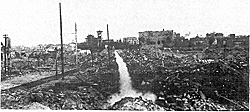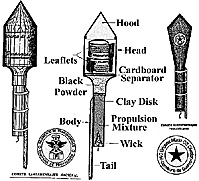When the fighting started in July 1936, both sides -- loyalists and rebels -- adopted policies of intense agitation and propaganda aimed at convincing the enemy soldiers to drop their arms and come over to the other side.

At right: Abajo: Lanzamiento de un cohete de propaganda nacional sobre las fuerzas defensoras republicanas de Madrid (barrio de Carabanchel). Diciembre 1937. [Launching of a "nationalist" propaganda rocket over the republican forces defending Madrid. (Carabanchel quarter). December 1937.]
As the complex psychological warfare developed, all sorts of means were used to send
oral and printed propaganda over the trenches. In this way, message-carrier or leaflet-carrier
rockets were born, spreading written, persuasive and threatening messages to the enemy for the
first time in the history of the mankind.
Quite satified by the effectiveness of the rockets, the Republican Army proudly released information about their new method of propaganda:
Experience was showing that every Republican launch of leaflet-carner rockets resulted in
the desertion of some nationalist soldiers to the Republican lines; this being the case, Franco's General Staff quickly decided to counterattack such propaganda by using the same methods. Evidence of this appeared on November 9th, 1937, in a classified document, which stated:
These two official references from the days of the Spanish Civil War have motivated us
to take a look at the characteristics of those curious artifacts that crossed the Spanish skies for more than two years.
Details
The following text, published by the 5th Regiment of Popular Militia (Milicias Populares),
gives us an idea of where such a propaganda device came from and how it needed to be altered:
It's quite clear that the rockets weren't "land-air missiles", as we might denominate them
today, but humble pyrotechnical devices common to traditional Spanish holidays. Even so, they
were well suited to the purpose of spreading propaganda.
According to our documentation, the section of the rocket holding the leaflets had a
diameter of 10 centimeters (4 inches), and a length of about 40 cm (16 inches), enabling it to
carry up to 800 silk-paper leaflets, of 9.5 x 14.5 centimetres (3.75x5.75 inches), while weighing only 200 grams (7 ounces). Each rocket weighed about 2 kg. (4 pounds 8 ounces), and could reach from 500 to 700 meters in altitude, although they normally used their propulsion energy to fly further instead of higher. While maintaining a similar weight, the rockets also launched dozens of reduced newspapers, loaves of bread, packs of cigarettes, or even samples of their soldiers' daily meals. [5]
As the summer of 1936 created a confusing geographical partition into two "Spains", the
Nationalists (Franco's rebels) found the armament industry balancing in their favor. At their
disposal were almost all the currently existing Maestranzas de Artilleria (armory and artillery
factories). The Republicans, on the other hand, had to requisition all kinds of manufacturers and factories to help produce guns, munitions and... message-carrier rockets.
The Popular Army (Republican) was supplied by the private pyrotechnical factories
located in the eastern zones of Spain (mainly in Godella-Valencia and Reus-Tarragona), while
Franco's rebel troops were heavily supplied by the munitions factories from the rest of Spain
(Seville, Toledo, Zaragoza and Valladolid).
Large Rocket Illustration (90K)
The Maestranza de Artilleria of Valladolid explained the characteristics,
composition and working mechanism in the following way:
The body's interior is filled with a substance composed by saltpeter, sulfur,
fine powder, and carbon; where the body and head meet there is a clay disk,
pierced in the center. The bore has a double wick accesible at the rear of the
body, although it remains hidden by a cardboard cover which is glued to the body
until the rocket is used; when the cover is removed, the wick must be taken out to
initiate the combustion that will produce the rocket's propulsion.
The messages are placed in the head, separated from the black powder by
the clay disk; once the wick is lit, the substance filling the body ingnites producing
the gases which thrust the rocket into the air; when the propulsion is used up, the
last bit of fire enters through the pierced hole of the c/ay disk into the compartment
where the ordinary black powder remains, causing an explosion that destroys the
rocket, thus releasing the contained messages. [6] A new evidence that before the Spanish Civil War message-carrier rockets were
completely unheard of, even beyond the Spanish borders, was published in the newspaper "Le
volontaire de la liberte" (The Freedom Volunteer) [7] written in French lenguage for and by the French volunteers of the International Brigades. [8] That article, called "The new artillery", exalted the soldiers, use of, and faith in, the army's latest weapon: propaganda.
No Originals Left
Although it has been all but impossible to find even a single, original example of message-carrier rockets from either side, we do know how the ones made by the Republicans looked by studying the posters and billboards printed by the Comisanado de Propaganda (Propaganda Commissioner) [9] and by examining some of the newspapers pnnted for the trenches. [10]
On the other hand, General Franco's Press and Propaganda Delegation of the State, was so indolent to divulge any information that the only known facts about the Nationalist message-carrier rockets come from the military booklets specially issued to the new officers being prepared to be sent immediately to the front.
[1] "La Trinchera". Bulletin of the 40a Brigada Mixta (7a Division). Year ll. NÝ 26. Madrid, 20th June 1937. p.2.
.... the political weapon of the Frente Popular (a joining of left minded
political parties), that the Commissioner has understood, guided and conducted
using leaflet-carrier rockets, that after bursting have spread waves of written
papers...[1]
Nowadays, the National Padio Company, 5th Section (Comparlia Radio
Nacional A.A. 5a Seccion) of this (Propaganda) Department, with the help of
Salamanca (Franco's General Headquarters), receives and distributes quite a lot
of equipment and leaflet-carrier rockets. [2]
These rockets have been used on holidays and night festivals to send up parachutes, etc.; today they spread leaflets and thus aid in the fight along with our other ammunition. The modifications that have been made are to the size of the rocket and the launching procedure. The rockets' volume allows them to be launched long distances and carry quite a relatively large number of leaflets. [3]
The (Propaganda) work being performed by the 1st, Company of Radio &
Propaganda is [....done] using message-carriers and rockets transporting up to 800
leaflets in each one for more than one kilometer...[4]
 The illustrations displayed on these pages, found in several civil and military archives,
show us how the types of message-carrier rockets varied in design, although their performance
was fairly similar.
The illustrations displayed on these pages, found in several civil and military archives,
show us how the types of message-carrier rockets varied in design, although their performance
was fairly similar.
The shape of the message-carrier rockets in shown in the fig. (1), consisting of a body (2), head (3), cone or hood (4), and tail. the body, head and hood are made of cardboard. The wooden tail is made with a stick, two meters long, tied to the body with a lacing cord.
Mais il y a egalement d'autres moyens qu'ont utilises les combattants de
leur propre initiative: le simples porte-voix, les fusees lance-tractes et les
amplificateur electriques... (But there also exist other ways [of propaganda warfare]
which are used by the combatants themselves and by their own initiative:
loudspeakers, message-carrier rockets and electrical amplifiers...)
Notes
[2] S.H.M. (Historical Militar Service). C.G.G. (Generalisimo's General Headquarters). Armario (Cabinet) 19 Legajo (Dossier) 6 Carpeta (Folder) 10.
[3] "Agitacion entre el enemigo" (Agitation to ward the enemy). Documentos historicos (Historical Documents.). Ediciones 5° Regimiento (5th Regiment printing works). Madrid, page 22.
[4] S.H.M. Red Documents (D.R.) A47 L855 C3 D1.
[5] The whole information commented along this article, shall be found with a deeper and more extense detail in the published book of this author: "Los cohetes lanzamensajes en la Guerra Civil Espanola. Guerra de Propaganda en los frentes. 1936-1939),
[6] Parque de Artilleria (Artillery Park) of Valladolid. "Municiones, Explosivos y Artificios, redactado pare la labor de enseffanza de los curves de artificieros preferentes" (Handbook on ammunitions, Explosives and artefacts, written for training purposes in the courses for officers). Papelea (Chapter) 35. pages 116/7.
[7] S.H.M. D.R. A47 L92 C12 D6.
[8] International Brigades were made up of foreign volunteers that went to Spain to join the Republican cause.
[9] Archivo Historico Nacional (Salamanca) (National Historical Archive). Seccion Guerra Civil (Sect on for Civil War). Hemeroteca. (Newspaper and magazine library). REV. 73/6.
[10] Revista (Magazine) "Estampa". N. 486, 15th May 1937.
Back to Abanderado Vol. 3 No. 1 Table of Contents
Back to Abanderado List of Issues
Back to MagWeb Master Magazine List
© Copyright 1997 by Rolfe Hedges
This article appears in MagWeb (Magazine Web) on the Internet World Wide Web. Other military history articles and gaming articles are available at http://www.magweb.com